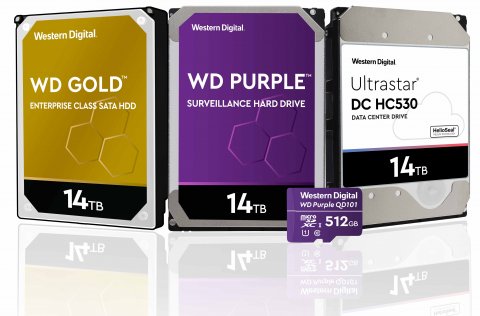Western Digital senior sales director for the Middle East Khwaja Saifuddin discusses the company’s innovative offerings for the smart video surveillance segment and shares insights into why storage is the unsung hero of smart and safe city technologies.

The race towards smart cities is all the rage today. Almost every government across the world are launching initiatives, signing partnerships and investing in tools and expertise that will enable them to build technologically empowered cities.
Surveillance technologies will be at the heart of these smart cities, ensuring not only the security and safety for citizens but also bolstering efficiency across a vast variety of critical infrastructure functions.
Smart cities need to have a robust and scalable video surveillance infrastructure. A study by research firm MarketsandMarkets noted that the global video surveillance market is projected to reach $68.3 billion by 2023. This figure highlights how organisations see the importance of investing in this IT segment to support their respective nations’ smart and safe city goals.
However, when most decision-makers think about a new video surveillance solution, they typically invest in the latest camera, video monitoring tools and video management software. What they need to realise is that storage is a key component to the success of any initiative involving video surveillance.
Khwaja Saifuddin, senior sales director – Middle East, Western Digital, says, “Several countries in the region are investing in the latest safe city technology innovations to keep their cities safe and secure. Video surveillance is a huge part of this technology and storage is its backbone.”
As with most technologies, video surveillance solutions collect huge volumes of data. For example, in the UK, there are over 8.2 million surveillance cameras, which produce 10.3 petabytes of visual data every hour, according to recent industry reports. While these data are fundamentally unstructured, they need to be stored over a number of years for legal and regulatory purposes, which require organisations and government authorities to have a robust storage solution. And for future smart cities, in particular, the amount of data that will be generated is endless.
“Surveillance systems often feature video analytics and high-definition image recording,” explains Saifuddin. “To manage the vast amounts of video and related metadata in an intelligent surveillance solution, it is absolutely critical for an organisation to have data storage that can read and write for such systems and has the utmost levels of performance ensuring that data integrity isn’t compromised.”
From ‘seeing’ to insights
Today’s surveillance industry is witnessing strong demands for higher-resolution cameras and new applications requiring real-time analytics.
Increasingly, video surveillance systems are being integrated with artificial intelligence (AI) and data analytics to ensure to provide organisations with actionable insights.
According to Saifuddin, AI-enabled video systems allow organisations to process, analyze and identify patterns on-site in real-time at the edge. This enables them to eradicate the need to deal with latency associated with transferring data and video off-site for analysis. This demands for storage devices that are capable of writing data at high speeds to keep up with these AI applications and simultaneously support both AI and video workloads.
“Traditional surveillance is often focused on post-event actions. Those days are behind us,” he says.
“Organisations today want to invest in surveillance devices that are more proactive and will give enable them with insights to take preemptive action. AI and analytics pave the way to achieving this.”
These insights, according to Saifuddin, are not solely focused on security measures. It also helps accelerate smart city initiatives such as traffic management by analysing data from surveillance cameras and integrating deep learning to recognise traffic patterns that will help curb congestions.
“It is undeniable that video surveillance is expanding and is transforming into a more intelligent science, therefore, we believe that storage too must evolve,” explains Saifuddin.
The power of storage
Western Digital seeks to play a key role in the evolution of smart video technology. Its ‘No Blind Spots,’ campaign encompasses a broad portfolio of storage solutions that supports today’s complex and advanced video and AI technologies.
“As the amounts of data being recorded continue to grow, Western Digital is committed to developing reliable storage and efficient access to critical data,” says Saifuddin.
“We are focused on innovating across the technology stack to prepare our customers for the zettabyte-scale age of the future and to build a flexible foundation for enabling access to faster intelligence.”
As part of its ‘No Blind Spots’ strategy, the company has optimised its storage products for 24/7 video surveillance cameras and feature high endurance with the capability to withstand extreme operating temperatures from -25˚ to 85˚C. Edge solutions are delivered through SSDs and purpose-built HDDs for Network Video Recorders (NVRs) with high capacity and high endurance allowing for many days of high-resolution video footage to be stored.
The WD Purple portfolio complements solutions that enhance smart video technology. The WD Purple microSD card provides long-lasting on-camera storage coupled with exceptional performance and reliability. Meanwhile, WD Purple Surveillance HDD features Western Digital’s AllFrame technology that helps create a security system tailored to the needs of the business.
As for enterprise-grade requirements, Western Digital’s Ultrastar NVMe series SSDs perform at the speed of today’s business needs. The Ultrastar HC 530 and WD Gold HDD are premier Cloud solutions. The Ultrastar HC 530 is a cost-effective option that allows for huge data storage capacities. Meanwhile, WD Gold HDD offers enterprise-class performance and exceptional reliability making it ideal for demanding environments.
Looking ahead
Saifuddin highlights that the biggest driver in the video surveillance space will be the evolution to 4K videos and the rise of 5G networks.
“A few years ago, the video surveillance market was mostly comprised of analogue cameras. To date, it has transformed into digital and in the future, we can expect demands for 4K videos,” he says.
Furthermore, he notes that there’s already a growing buzz in the market for the development of 8K videos.
“What does this mean for storage? Well, these high-definition videos mean the images that these cameras will produce will have higher resolutions and will, therefore, have big file sizes. This means organisations will require more space to store these data, and with more space, they need more Western Digital drives,” explains Saifuddin.
To support this future requirement, Western Digital is already testing new products with larger capacities from including 18 to 20 terabytes HDDs.
“We are at the forefront of developing storage solution with the largest capacity. We have a very strong history of pioneering industry-leading innovations in this segment because of the amount of talent and expertise that we have at Western Digital.”





